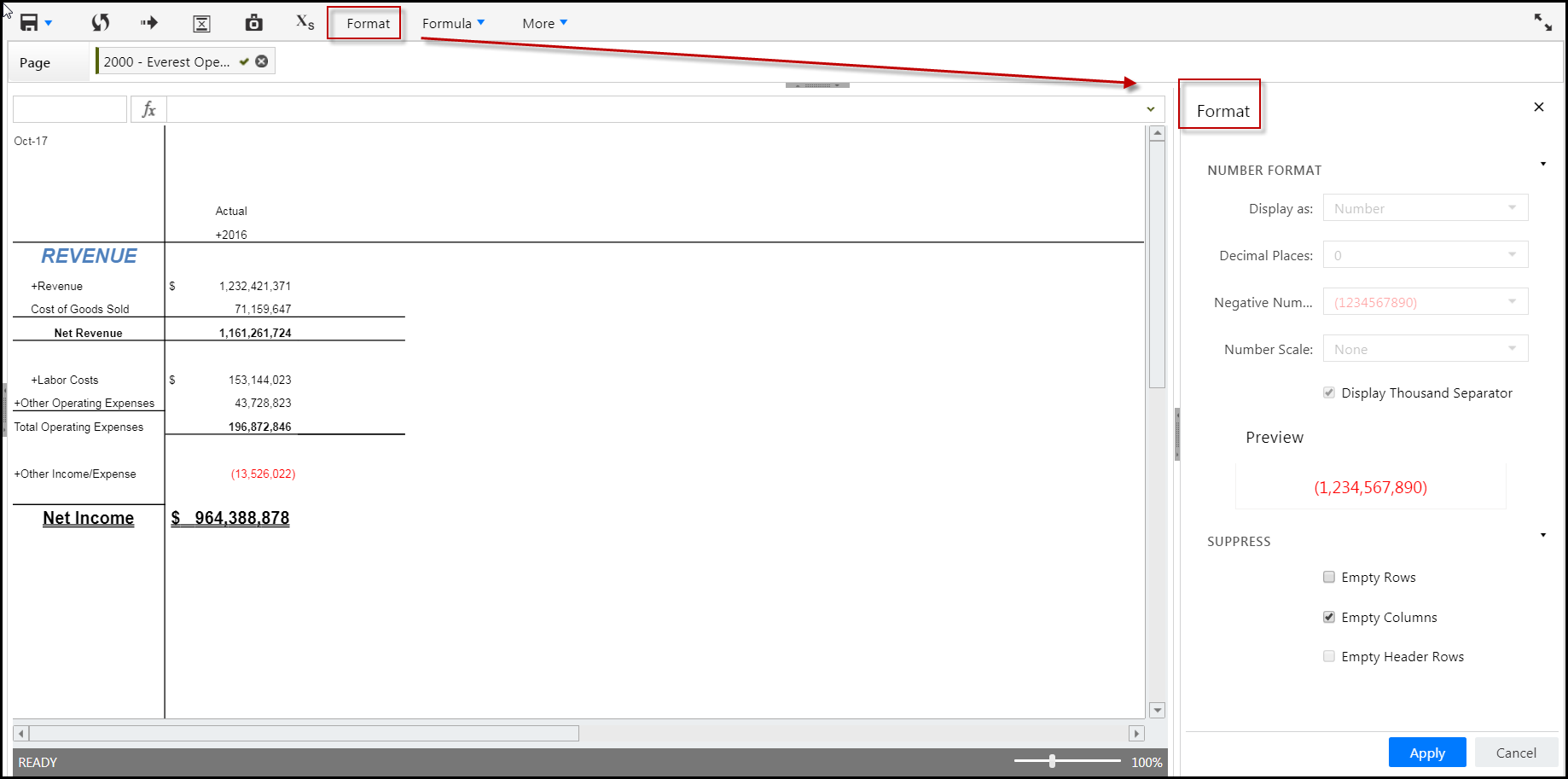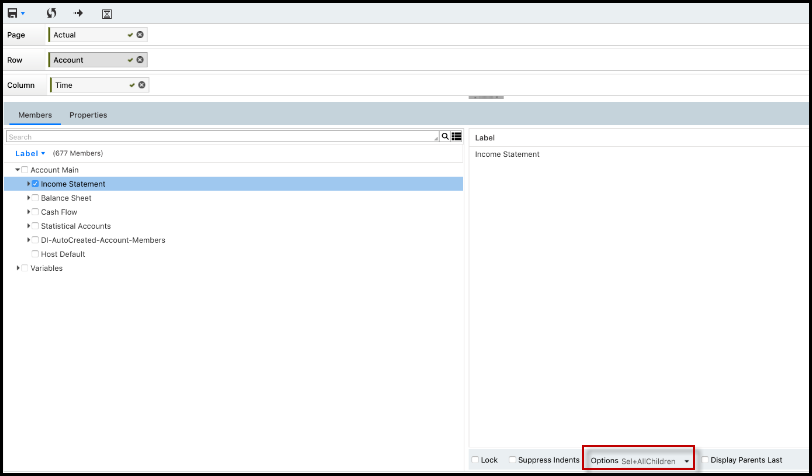- 6 Minutes to read
- Print
- DarkLight
- PDF
Dynamic Reports - How Tos
- 6 Minutes to read
- Print
- DarkLight
- PDF
How to modify the look and feel of Dynamic Report
The information below provides details on how to modify the design of Dynamic Report output as the design of reports consumed (or data pulled) into a Dynamic Report is based on the original report setup.
In Practice
Let’s say you have a report set called Net Income in your Dynamic Report. Net Income displays in your Dynamic Report with a purple background, which you don't like. To change the color of the output, in this case, open and edit the Report Set. To do so:
Navigate to the File Cabinet and locate the Report Set (in this case it is called Income Statement Base).
Select the checkbox next to Income Statement Base and click Setup.
On the Report Set Setup page, select the line and click Format.
Select a different Background Color.

Click Save. Return to the Dynamic Report and click Run. Net Income will now have a new background color.
For more information on formatting reports, refer to Working with Dynamic Reports topic.<>
How to access the format pane
Within the Dynamic Report interface, click Format to launch the Format pane.
The format bar will appear differently based on if you have opted in to Cell Level Formatting, a feature that allows you to format Dynamic report output down to the individual cell level, or have Standard Formatting functionality.

How to reset formatting selections
Let's say you made several formatting selections, but want to return to the default formatting, click the Reset icon. The Reset icon on the top of the Format pane resets the format values to the defaults.

How to resize and save groups of columns in a Dynamic Report
Select multiple columns at once in Dynamic Report output using shortcut keys, resize the width for all selected columns and then perform a Save. When you perform a Save (with Save Columns Widths selected in the toolbar), all column widths are retained even when the report is closed and then reopened. Prior to this release, only the first resized column could be saved in a Dynamic Report and all other columns reverted to a default width unless you resized each column individually.
In Practice
Open a Dynamic Report.
Hold the SHIFT key to select the contiguous columns to resize. Or, hold the CTRL key to select disparate columns
Drag the column line (shown in the image below) to the appropriate size.
Click Save.

How to export All Members in a Rollup in a Dynamic Report using the Export to Excel
For example, if you have an account group called Income Statement and you want to see the individual accounts that roll up to Income Statement when you export the report to Excel, complete the following steps.
- Open the Dynamic Report and select the Select All Childrenoption in Member Selector.

- Run the report. The hierarchy will be expanded to show all individual accounts.
- Export to Excel and all accounts will be shown as in the output when you ran the report.
How to display Template Notes in a Dynamic Report
Open the Dynamic Report.
Click the More listbox.
Select Show Notes. You can also select Hide Notes to hide them from display.

Once you click Show Notes, a Notes column is displayed on the report and notes are displayed for each line in the report. Notes are always vertically bottom aligned like the other cells in the report.
A date/time stamp with user name is added to the beginning of each note. The date/time stamp format is applied based on user location and language settings. The maximum number of characters displayed in the notes field is 1024, which includes that username and date/time stamp.
Notes are aggregated and displayed when coming from several sources. For example, notes sourced from multiple templates for the account and scenario combination. Consolidation happens for multiple scenarios, companies, departments, and so on for the page or column axis for leaf members in the hierarchy.
Notes are retained when running a Dynamic Report in a Report Collection or Financial Package Publisher. Notes are also retained when the Dynamic Report is sent in an email or exported and when you save a snapshot of a Dynamic Report.
Notes are not time bound. For example, if a scenario’s duration is Jan 17 to Jan 19, but the time selected in the report is Dec 16, notes are till displayed for these lines even though data does not exist on those scenarios for Dec 16.
If you suppress empty rows/columns, corresponding notes are also suppressed. Similarly, if the report line does not have any data, notes are also not displayed for those lines.
Exporting Dynamic Reports Output in Unprotected View
Use unprotected view to edit exported Dynamic Reports. Complete the following steps to export your reports in unprotected view:
- Open Microsoft Excel.
- Select File, Options.
- Under Options, select Trust Center in the left pane.
- Click Trust Center Settings.
- Click the Protected View in the left pane of Trust Center window.
- Uncheck Enable Protected View for files originating from the Internet and Enable Protected View for files located in potentially unsafe locations options.
- Click OK.
How to Modify a Dynamic Report from the Template Interface Accessed from the Planning Control Panel
Dynamic Reports is a reporting tool which provides easy-to-use, ad hoc query capabilities, as well as structured financial reports which utilize reusable report sets. Dynamic Reports use dimensional data and may use report sets and attributes to produce a specific output.
Overview
A full access user or reporting administrator can access a Dynamic Report linked to a Template from the Planning Control Panel.
A full access user can modify the design of the report (as in the Dynamic Report interface) and save changes made to the Dynamic Report from the Planning Control Panel. Users with read-only or regular user access without edit permission can make changes, but cannot save (or save as) these changes to the report. If an object on the page is locked, a read-only user will not be able to modify member selections for that dimension.
The following modifications can be applied to a Dynamic Report accessed from the Planning Control Panel:
Drag and drop objects from the left pane into the layout area.
Drag and drop objects from the layout area to reorder or remove them.
Make changes to member selections on the page/row/column axes.
Make changes to the header/footer.
Make changes to items such as suppression, format, insert formulas, formula exceptions, rank, sort, charts (if opened), pivot, grid actions, substitution variables values, and pick list.
A full access user or reporting administrator can save the changes back to the original report or perform a Save As.
When you map Dynamic Reports to Templates and execute the report, the original report selections are replaced on the Scenario and Budget Entity combination segments (if applied to the page) with the selections from the budget templates and entity mappings. These selections are applied from the budget templates/entity mappings only if the dimensions/attributes/attribute hierarchies exist at the page level in the Dynamic Report. However, the selections for Scenario and Budget Entity combinations are not updated automatically in the original Dynamic Report. For all other dimensions/attributes/ attribute hierarchies and objects on the row or column axis, the original report selections are retained when the Dynamic Report is run from the Planning Control Panel.

